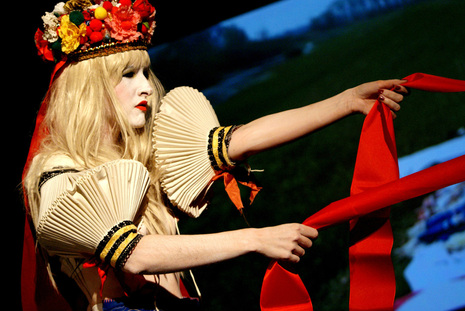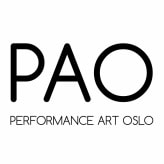interview with tereza buskova
 Rituals of Spring Equinox, live performance, 176 Zabludowicz Collection, London, 2009.
Rituals of Spring Equinox, live performance, 176 Zabludowicz Collection, London, 2009.
15. 09. 2014
Q: Why / when / how did you start to work with performance, what is your background, how did you arrive at doing performance?
My interest in performance emerged from making films which were documentations of semi-improvised rituals. I developed this approach after I graduated from the Royal College of Art in London, 2007. One valued college tutor once commented that the actual process of constructing my films would be an interesting form on its own. She thought that it should be experienced live by the public. This has become an integral part of my art.
Q: What is your process like when you make a performance, from idea to actual work?
As an artist I celebrate and re-interpret long established customs through different media. My work is not just built on the existing facts of past folk traditional practices. It is a female exploration of the feelings and fantasies bound up in our rich festive celebrations. My performances depict a surreal portrait of the Slavic rites of passage, which reflect not only the change of season, but also sexuality, fertility, and the powers of rural mythology. After researching how people faithfully practice their traditions and rituals I then reinvent them with my Czech and British collaborators. The main performer (and probably my alter ego) Zoe Simon - actress & writer, together with experimental cellist & music composer Bela Emerson have continuously contributed to realizing and re-interpreting my vision.
Q: Can you tell about your latest project?
In the Spring of 2015 together with Polish Expacts and Centrala Gallery, I will create a performance – a dialogue with the communities of Birmingham with a live performance outside a practicing church. We will explore social traditions and rituals through re-staging the long forgotten pagan tradition: “Clipping the Church”. I will be working closely with the local mothers and children, together we will produce and decorate the church in a symbolic pastry and more importantly we will “embrace” and “clip” together this ‘Mother church’.
Q: What role does performance art have in your life / artistic praxis. Do you also work within other fields, like installation, sculpture, drawing, other expressions. How do they influence / inform each other?
There is an element of a performance in all my work which usually comprises of film and print. In fact, I do not separate my life from my art, let alone the media used. My work has always been very visual, layered with theatrical performative imagery, reminiscent of Tableaux Vivant.
Q: How do you experience or consider the audience / surrounding. What space / surrounding do you find interesting to work in. How does your surrounding influence your work. Do you involve the public? If so how?
An audience plays quite a big role in my art. My aim is for myself and my performers to closely observe an existing tradition faithfully practiced by the local people. These traditions / rituals always have an audience. The audience is vital to their performance as the public gets involved and therefore these old traditions can be passed on. For these reasons, my performance needs its audience and participants to mirror and reinvent the old traditions with me.
<< Back
Q: Why / when / how did you start to work with performance, what is your background, how did you arrive at doing performance?
My interest in performance emerged from making films which were documentations of semi-improvised rituals. I developed this approach after I graduated from the Royal College of Art in London, 2007. One valued college tutor once commented that the actual process of constructing my films would be an interesting form on its own. She thought that it should be experienced live by the public. This has become an integral part of my art.
Q: What is your process like when you make a performance, from idea to actual work?
As an artist I celebrate and re-interpret long established customs through different media. My work is not just built on the existing facts of past folk traditional practices. It is a female exploration of the feelings and fantasies bound up in our rich festive celebrations. My performances depict a surreal portrait of the Slavic rites of passage, which reflect not only the change of season, but also sexuality, fertility, and the powers of rural mythology. After researching how people faithfully practice their traditions and rituals I then reinvent them with my Czech and British collaborators. The main performer (and probably my alter ego) Zoe Simon - actress & writer, together with experimental cellist & music composer Bela Emerson have continuously contributed to realizing and re-interpreting my vision.
Q: Can you tell about your latest project?
In the Spring of 2015 together with Polish Expacts and Centrala Gallery, I will create a performance – a dialogue with the communities of Birmingham with a live performance outside a practicing church. We will explore social traditions and rituals through re-staging the long forgotten pagan tradition: “Clipping the Church”. I will be working closely with the local mothers and children, together we will produce and decorate the church in a symbolic pastry and more importantly we will “embrace” and “clip” together this ‘Mother church’.
Q: What role does performance art have in your life / artistic praxis. Do you also work within other fields, like installation, sculpture, drawing, other expressions. How do they influence / inform each other?
There is an element of a performance in all my work which usually comprises of film and print. In fact, I do not separate my life from my art, let alone the media used. My work has always been very visual, layered with theatrical performative imagery, reminiscent of Tableaux Vivant.
Q: How do you experience or consider the audience / surrounding. What space / surrounding do you find interesting to work in. How does your surrounding influence your work. Do you involve the public? If so how?
An audience plays quite a big role in my art. My aim is for myself and my performers to closely observe an existing tradition faithfully practiced by the local people. These traditions / rituals always have an audience. The audience is vital to their performance as the public gets involved and therefore these old traditions can be passed on. For these reasons, my performance needs its audience and participants to mirror and reinvent the old traditions with me.
<< Back
